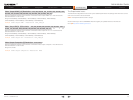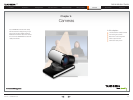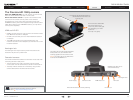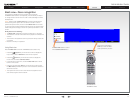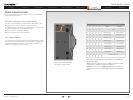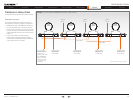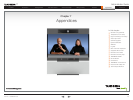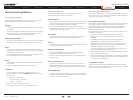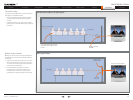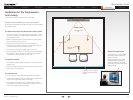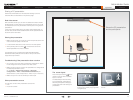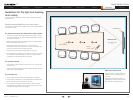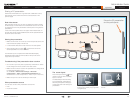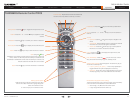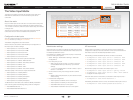
D14274.01—NOVEMBER 2008
41
T1
Administrator Guide
Contents Introduction Getting started About the menus About the settings Settings Library Cameras Appendices Contact us
Appendices
General room guidelines
The physical conditions
When building a video meeting room, or using an existing room for
video meetings there are a few guidelines to consider.
Lighting
The illumination should be distributed evenly in the room to obtain •
low contrast
The ideal light intensity is a little higher than in an ordinary meeting •
room. Typically, the luminous intensity should be 800–1400Lux,
measured at the table with an incident light meter
Seating area and table
The seating area and table should be non-shiny and non-patterned•
The seating area should allow all participants to see the monitor•
Walls
The color of the wall should be in good contrast to skin tonality. •
Light blue is a complementary color to skin tonality, it gives a good
contrast and is commonly used
Acoustically reflective surfaces (such as glass or concrete) should •
be covered with curtains or sound treatment
Audio
The Noise Floor (the sum of all the noise sources) should be less •
than 44 dBC
The reverberation time should be 0,3 to 0,5 seconds•
Ventilation
The requirements for ventilation is a little higher than in an •
ordinary meeting room as the TANDBERG T1 has the following
specifications:
Max rating – 800 Watts•
Normal operation – 650 Watts•
Standby – 160 Watts•
Keep in mind the Noise Floor (see Audio)•
Velocity creates noise, therefore keep velocity of air low•
The room equipment
When placing and using the room equipment there are a few
recommendations and guidelines to consider.
The microphone
The microphones should be evenly distributed on the table. Avoid •
positions where they can be hidden behind obstacles like laptop,
projector or other equipment placed on the table
Do not place a microphone close to power outlets or similar •
arrangements on the table. The microphone will pick up noise from
these arrangements quite strongly
The camera
The camera should be able to “see” all participants in the room. •
Use the pan, tilt and zoom features to adjust the picture
The PC
PC’s placed on the table should not cover the microphones as this •
will reduce the audio quality at the far end
Position of the system
Position the TANDBERG T1 in such a way that all participants •
attending the meeting are visible to the far end
If appropriate, the far end should be able to see people entering or •
leaving the room
The document camera
The document camera should be close to the chair person or a •
designated controller of the document camera for ease of use
Make sure this person is visible on screen while carry out the task
Other peripherals
Arrange all the peripherals so that the chair person can reach each •
of them to point, change the display, DVD, and still be fully visible
on screen while carry out the task
Environmental considerations
This section explains how to carry out basic adjustments and simple
tests to ensure that you send and receive the best possible image and
audio quality when using your system.
Iris control and lighting
By default the system camera will use an automatic iris to compensate
for changes in lighting. In addition to this feature, you may further
assist the system to maintain the best possible image quality by
paying special attention to environmental lighting and background
colors as described below.
Remember the system will send live images of both yourself and your
immediate surroundings.
Avoid direct sunlight on the subject matter i.e. yourself, the •
background or onto the camera lens as this will create harsh
contrasts
Avoid placing the seatings in front of a window with natural •
daylight, as this will make the faces of people very dark
If light levels are too low you may need to consider using artificial •
lighting. As described above, direct illumination of the subject
matter and camera lens should be avoided
When using artificial lighting, daylight type lamps will produce the •
most effective results. Avoid colored lighting
Indirect light from shaded sources or reflected light from pale walls •
often produces excellent results
Avoid harsh side lighting or strong light from above. Strong sunlight •
from a window or skylight may put part or all of the subject matter
in shadow or cause silhouetting
Loudspeaker volume
The audio system will use the Digital Natural Audio Module (DNAM)
which is integrated in the system. The volume of the audio is controlled
by the Volume key on the remote control.



